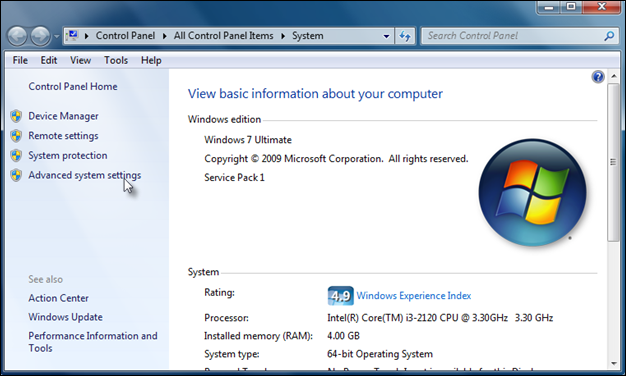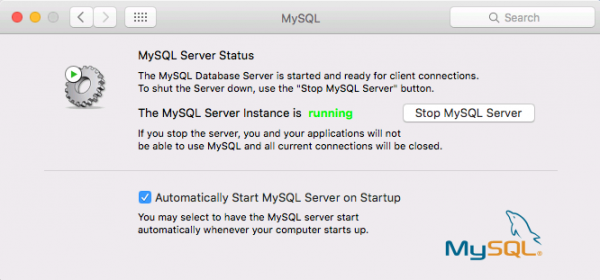
- Add Mysql To Path Mac
- Mac Add Mysql To Path File
- Add Mysql To Path Mac Catalina
- Add Mysql To Path Mac Zsh
- Mac Add Mysql To Path Tool
By default, XAMPP has no passwords set and it is not recommended to run XAMPP with this configuration as it is accessible to others.
MySQL: IP-address of the Server. Make sure, there is a mysql server running. To start, use MySQL/SettingupMySQL this guide. MySQL: 3306 is the default mysql port. No need to change it. MySQL: Name of the database. You manually need to create this database on the mysql server (use phpMyAdmin) MySQL: Username.
Simply type the following command (as root) to start a simple security check:
- To work properly, these programs must be added to your Mac OS X system path. To add the MySQL command prompt programs that come with MAMP to your Mac OS X system path, follow these instructions.
- A directory in your PATH = a warehouse 📦 I popped open a Mac with a fresh install of. Paths file or add the custom PATH. Is add the path to this MYSQL /bin folder to our PATH.
sudo /Applications/XAMPP/xamppfiles/xampp security
Now you should see the following dialog on your screen:
XAMPP: Quick security check...
XAMPP: MySQL is accessable via network.
XAMPP: Normaly that's not recommended. Do you want me to turn it off? [yes] yes
XAMPP: Turned off.
XAMPP: Stopping MySQL...
XAMPP: Starting MySQL...
XAMPP: The MySQL/phpMyAdmin user pma has no password set!!!
XAMPP: Do you want to set a password? [yes] yes
XAMPP: Password: ******
XAMPP: Password (again): ******
XAMPP: Setting new MySQL pma password.
XAMPP: Setting phpMyAdmin's pma password to the new one.
XAMPP: MySQL has no root passwort set!!!
XAMPP: Do you want to set a password? [yes] yes
XAMPP: Write the passworde somewhere down to make sure you won't forget it!!!
XAMPP: Password: ******
XAMPP: Password (again): ******
XAMPP: Setting new MySQL root password.
XAMPP: Setting phpMyAdmin's root password to the new one.
XAMPP: The FTP password for user 'nobody' is still set to 'lampp'.
XAMPP: Do you want to change the password? [yes] yes
XAMPP: Password: ******
XAMPP: Password (again): ******
XAMPP: Reload ProFTPD...
XAMPP: Done.
(1) Setting a password will protect the XAMPP demo pages (http://localhost/xampp/) using this password. The user name is 'lampp'!
After running this command, your XAMPP installation should be more secure.
Summary: in this tutorial, you will learn how to use MySQL JSON data type to store JSON documents in the database.
Introduction to MySQL JSON data type
MySQL supports the native JSON data type since version 5.7.8. The native JSON data type allows you to store JSON documents more efficiently than the JSON text format in the previous versions.
MySQL stores JSON documents in an internal format that allows quick read access to document elements. The JSON binary format is structured in the way that permits the server to search for values within the JSON document directly by key or array index, which is very fast.
The storage of a JSON document is approximately the same as the storage of LONGBLOB or LONGTEXT data.
Add Mysql To Path Mac

Mac Add Mysql To Path File
To define a column whose data type is JSON, you use the following syntax:
Notice that a JSON column cannot have a default value. In addition, a JSON column cannot be indexed directly. Instead, you can create an index on a generated column that contains values extracted from the JSON column. When you query data from the JSON column, the MySQL optimizer will look for compatible indexes on virtual columns that match JSON expressions.
MySQL JSON data type example
Suppose, we have to track the visitors and their actions on our website. Some visitors may just view the pages and other may view the pages and buy the products. To store this information, we will create a new table called events.
Each event in the events table has an id that uniquely identifies the event. An event also has a name e.g., pageview, purchase, etc., The visitor column is used to store the visitor information.
The properties and browser columns are the JSON columns. They are used to store properties of an event and specification of the browser that visitors use to browse the website.

Let's insert some data into the events table:
To pull values out of the JSON columns, you use the column path operator ( ->).
This query returns the following output:
Notice that data in the browser column is surrounded by quote marks. To remove the quote marks, you use the inline path operator (->>) as follows:

As you can see in the following output, the quote marks were removed:
To get the browser usage, you can use the following statement:
The output of the query is as follows:
Add Mysql To Path Mac Catalina
To calculate the total revenue by the visitor, you use the following query:
Add Mysql To Path Mac Zsh
Here is the output:

- Add Mysql To Path Mac
- Mac Add Mysql To Path File
- Add Mysql To Path Mac Catalina
- Add Mysql To Path Mac Zsh
- Mac Add Mysql To Path Tool
By default, XAMPP has no passwords set and it is not recommended to run XAMPP with this configuration as it is accessible to others.
MySQL: IP-address of the Server. Make sure, there is a mysql server running. To start, use MySQL/SettingupMySQL this guide. MySQL: 3306 is the default mysql port. No need to change it. MySQL: Name of the database. You manually need to create this database on the mysql server (use phpMyAdmin) MySQL: Username.
Simply type the following command (as root) to start a simple security check:
- To work properly, these programs must be added to your Mac OS X system path. To add the MySQL command prompt programs that come with MAMP to your Mac OS X system path, follow these instructions.
- A directory in your PATH = a warehouse 📦 I popped open a Mac with a fresh install of. Paths file or add the custom PATH. Is add the path to this MYSQL /bin folder to our PATH.
sudo /Applications/XAMPP/xamppfiles/xampp security
Now you should see the following dialog on your screen:
XAMPP: Quick security check...
XAMPP: MySQL is accessable via network.
XAMPP: Normaly that's not recommended. Do you want me to turn it off? [yes] yes
XAMPP: Turned off.
XAMPP: Stopping MySQL...
XAMPP: Starting MySQL...
XAMPP: The MySQL/phpMyAdmin user pma has no password set!!!
XAMPP: Do you want to set a password? [yes] yes
XAMPP: Password: ******
XAMPP: Password (again): ******
XAMPP: Setting new MySQL pma password.
XAMPP: Setting phpMyAdmin's pma password to the new one.
XAMPP: MySQL has no root passwort set!!!
XAMPP: Do you want to set a password? [yes] yes
XAMPP: Write the passworde somewhere down to make sure you won't forget it!!!
XAMPP: Password: ******
XAMPP: Password (again): ******
XAMPP: Setting new MySQL root password.
XAMPP: Setting phpMyAdmin's root password to the new one.
XAMPP: The FTP password for user 'nobody' is still set to 'lampp'.
XAMPP: Do you want to change the password? [yes] yes
XAMPP: Password: ******
XAMPP: Password (again): ******
XAMPP: Reload ProFTPD...
XAMPP: Done.
(1) Setting a password will protect the XAMPP demo pages (http://localhost/xampp/) using this password. The user name is 'lampp'!
After running this command, your XAMPP installation should be more secure.
Summary: in this tutorial, you will learn how to use MySQL JSON data type to store JSON documents in the database.
Introduction to MySQL JSON data type
MySQL supports the native JSON data type since version 5.7.8. The native JSON data type allows you to store JSON documents more efficiently than the JSON text format in the previous versions.
MySQL stores JSON documents in an internal format that allows quick read access to document elements. The JSON binary format is structured in the way that permits the server to search for values within the JSON document directly by key or array index, which is very fast.
The storage of a JSON document is approximately the same as the storage of LONGBLOB or LONGTEXT data.
Add Mysql To Path Mac
Mac Add Mysql To Path File
To define a column whose data type is JSON, you use the following syntax:
Notice that a JSON column cannot have a default value. In addition, a JSON column cannot be indexed directly. Instead, you can create an index on a generated column that contains values extracted from the JSON column. When you query data from the JSON column, the MySQL optimizer will look for compatible indexes on virtual columns that match JSON expressions.
MySQL JSON data type example
Suppose, we have to track the visitors and their actions on our website. Some visitors may just view the pages and other may view the pages and buy the products. To store this information, we will create a new table called events.
Each event in the events table has an id that uniquely identifies the event. An event also has a name e.g., pageview, purchase, etc., The visitor column is used to store the visitor information.
The properties and browser columns are the JSON columns. They are used to store properties of an event and specification of the browser that visitors use to browse the website.
Let's insert some data into the events table:
To pull values out of the JSON columns, you use the column path operator ( ->).
This query returns the following output:
Notice that data in the browser column is surrounded by quote marks. To remove the quote marks, you use the inline path operator (->>) as follows:
As you can see in the following output, the quote marks were removed:
To get the browser usage, you can use the following statement:
The output of the query is as follows:
Add Mysql To Path Mac Catalina
To calculate the total revenue by the visitor, you use the following query:
Add Mysql To Path Mac Zsh
Here is the output:
Mac Add Mysql To Path Tool
In this tutorial, you have learned about the MySQL JSON data type and how to use it for storing JSON documents in the database.
